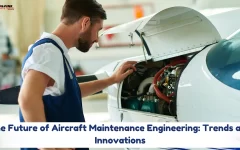Career Opportunities After Completing the AME A1 Course
2024-12-18 8:44Career Opportunities After Completing the AME A1 Course
The aviation industry is one of the most dynamic and rapidly growing sectors in the world. As air traffic continues to increase, the demand for skilled professionals who can ensure the safety and reliability of aircraft is at an all-time high. Among these professionals, Aircraft Maintenance Engineers (AMEs) play a critical role in keeping aircraft in optimal flying condition. Specifically, the AME A1 course, which focuses on airframe maintenance, opens the door to a wide range of career opportunities within the aviation industry.
If you’ve completed the AME A1 course or are considering it, you might be wondering what job prospects and career paths are available to you..
1. Aircraft Maintenance Engineer (AME) – Airframe Specialist
One of the most direct career paths after completing the AME A1 course is to work as an Aircraft Maintenance Engineer (AME) specializing in airframes. This role is central to ensuring the safety, performance, and structural integrity of the aircraft.
Key Responsibilities:
- Inspecting airframe components like wings, fuselage, landing gear, and tail structures for any signs of damage or wear.
- Performing repairs and replacements to maintain the structural integrity of the aircraft.
- Following safety protocols and regulations to ensure all work complies with industry standards (such as FAA, EASA, and DGCA).
- Working closely with other engineers to troubleshoot and resolve issues that may affect the aircraft’s performance.
Career Outlook:
- Airlines: Major commercial airlines always need skilled AMEs to maintain their fleets. Whether it’s a passenger aircraft or a cargo plane, ensuring that airframes are in top condition is a constant requirement.
- Airframe Manufacturers: Companies that design and build aircraft need AMEs to test, inspect, and oversee the construction of new airframes.
- Military Aviation: The defense sector requires AME specialists to work on military aircraft, ensuring they are ready for operations.
2. Aircraft Maintenance Technician
As an Aircraft Maintenance Technician (AMT), you’ll work alongside AMEs and other engineers, supporting the maintenance and inspection of aircraft airframes. This role is ideal for those who enjoy hands-on, technical work and want to get involved in aircraft upkeep without necessarily being in charge of full engineering responsibilities.
Key Responsibilities:
- Assisting AMEs in inspecting and repairing airframes under their supervision.
- Performing basic structural maintenance tasks, such as cleaning, painting, and checking for wear and tear.
- Testing systems and components to ensure the airframe is functioning properly.
Career Outlook:
- Aviation Maintenance Organizations: Many independent repair organizations (MROs) hire technicians to perform routine maintenance and repairs on aircraft.
- Corporate Aviation: Smaller aircraft operators or private aviation companies often employ technicians to maintain their fleets.
3. Aviation Maintenance Planner
Aviation maintenance planning is crucial for ensuring that aircraft maintenance schedules are adhered to and that airframes receive timely inspections and repairs without disrupting airline operations. As a Maintenance Planner, your job will focus more on the organizational and scheduling aspects of aircraft maintenance.
Key Responsibilities:
- Developing maintenance schedules for airframe inspections, repairs, and upgrades.
- Coordinating with various teams to ensure that all maintenance tasks are completed on time.
- Managing spare parts inventories and ordering the necessary materials for repairs.
- Ensuring compliance with industry regulations and ensuring all maintenance work is documented accurately.
Career Outlook:
- Airlines: Airlines need maintenance planners to manage the maintenance and servicing schedules of their fleets, which can include hundreds or thousands of aircraft.
- Aircraft Operators: Operators of large private fleets or corporate aviation companies often require a maintenance planner to ensure their aircraft are ready for use at all times.
4. Aircraft Safety Inspector
Aircraft safety inspectors play a vital role in ensuring that every aspect of an aircraft, including its airframe, complies with national and international safety standards. This is a specialized career that requires not only technical expertise but also a strong understanding of regulatory frameworks governing aviation.
Key Responsibilities:
- Conducting safety inspections on airframes to ensure they meet aviation standards.
- Identifying potential issues that could pose a risk to flight safety, from structural weaknesses to design flaws.
- Collaborating with regulatory bodies like the FAA (Federal Aviation Administration) or DGCA to ensure compliance with safety standards.
Career Outlook:
- Civil Aviation Authorities: As a government or aviation regulatory body employee, you could inspect airframes and ensure airlines and aviation companies are following safety protocols.
- Independent Organizations: Some private firms offer aircraft safety audits for companies looking to enhance the safety and compliance of their aircraft.
5. Private Jet Maintenance Engineer
The rise of private aviation has led to an increasing demand for skilled aircraft maintenance engineers in the private jet sector. Working on private jets offers unique opportunities for AME A1 engineers, often involving more personalized and high-touch maintenance for individual or corporate clients.
Key Responsibilities:
- Conducting detailed inspections and repairs on the airframes of private jets, which often have specialized needs.
- Maintaining a high standard of care for luxury or executive aircraft, where appearance and performance are equally important.
- Customizing maintenance schedules based on the specific needs of private aircraft owners.
Career Outlook:
- Private Jet Companies: Working for charter services or corporate jet fleets.
- VIP Maintenance Services: Some maintenance organizations specialize in servicing high-end private jets, offering premium services to private owners.
6. Aircraft Structural Engineer
An Aircraft Structural Engineer focuses on the design, analysis, and testing of airframe components to ensure they are strong enough to withstand the various stresses encountered during flight. While this role typically requires additional qualifications and experience in engineering, the AME A1 course provides a solid foundation for those looking to transition into aircraft design.
Key Responsibilities:
- Designing and testing new airframe structures for aircraft manufacturers.
- Analyzing the performance of materials and components used in aircraft construction.
- Collaborating with manufacturers to improve airframe designs, ensuring greater efficiency and safety.
Career Outlook:
- Aircraft Manufacturers: Companies like Boeing, Airbus, and smaller aircraft manufacturers often hire structural engineers to assist in developing new aircraft designs.
- Research and Development: Companies involved in advancing aviation technologies rely on structural engineers to innovate and improve airframe designs.
7. Aircraft Welding Specialist
As part of airframe maintenance, welding plays a significant role in repairing or reinforcing aircraft structures. Aircraft Welding Specialists are highly skilled in using various welding techniques to repair metal components on the airframe.
Key Responsibilities:
- Performing welding operations on airframe structures to repair or reinforce damaged sections.
- Ensuring the integrity of welded joints, using techniques like MIG welding, TIG welding, and other specialized methods.
- Working with a variety of materials, from lightweight alloys to heavy-duty metals used in airframe construction.
Career Outlook:
- Maintenance Organizations: MROs often hire welding specialists to handle structural repairs and ensure that damaged airframe parts are restored to their original strength.
- Aircraft Manufacturers: Manufacturers require welding specialists to assist in building airframes during the assembly process.
Conclusion: A World of Opportunities
The AME A1 course, which focuses on airframe maintenance, opens up a broad spectrum of career opportunities within the aviation industry. From hands-on roles in airlines and aviation maintenance organizations to high-level positions in private aviation and aircraft design, graduates of the AME A1 course are in high demand worldwide. Whether you’re looking to specialize in structural repair, inspection, planning, or even aircraft design, a career as an Aircraft Maintenance Engineer offers a wealth of opportunities to build a fulfilling and rewarding career in the ever-growing aviation sector. With aviation continuing to expand, the future looks bright for skilled airframe engineers and maintenance professionals.









